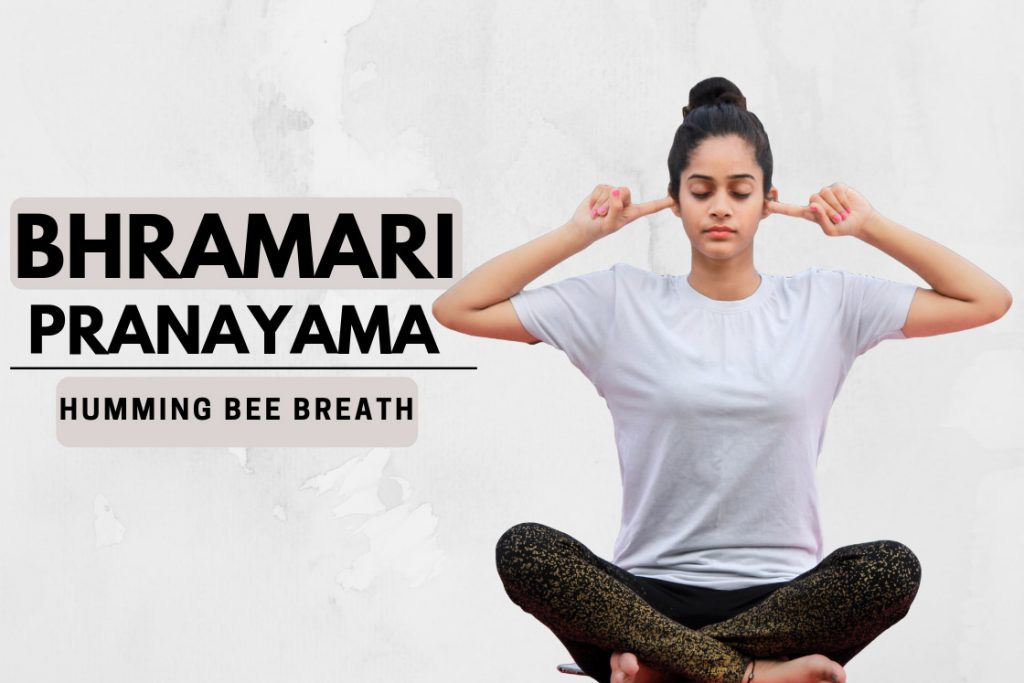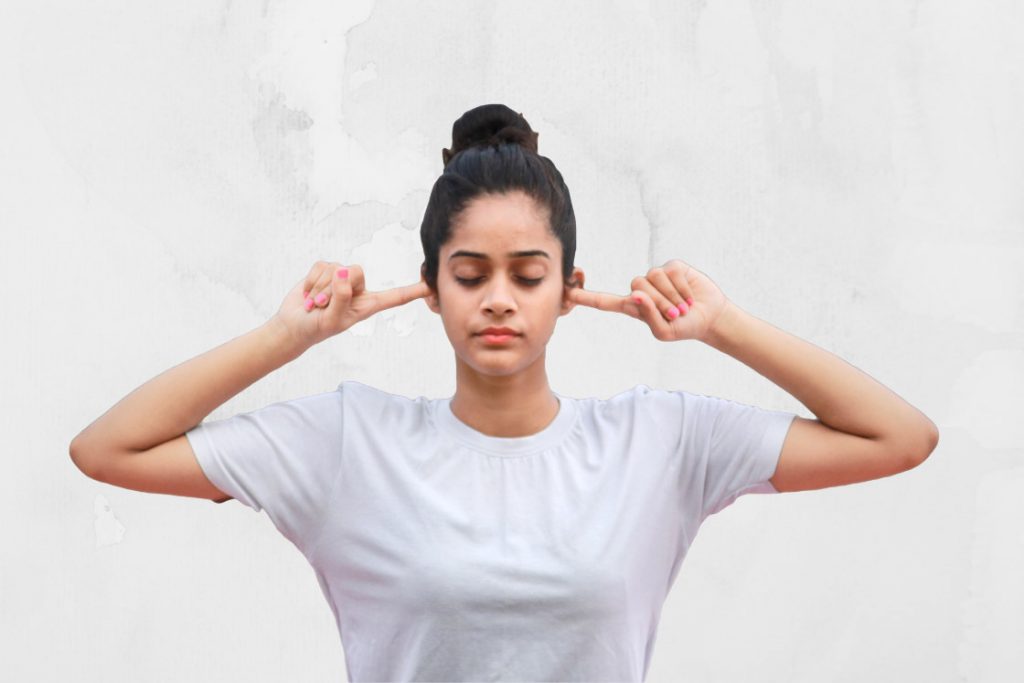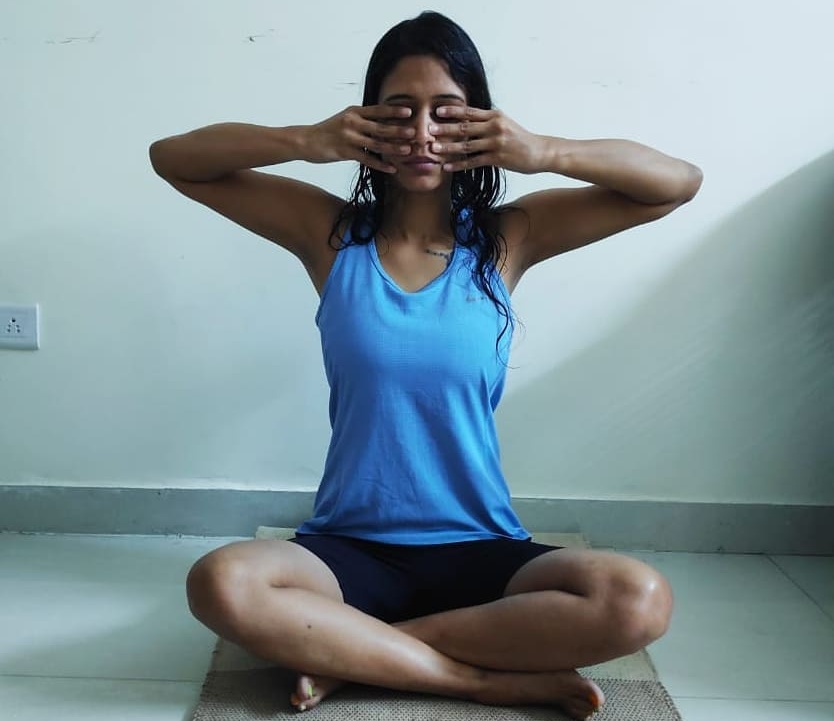
Bhramari Pranayama is a breathing exercise of yoga in which you make a humming sound from the throat while exhalation.
As pranayama benefits the body and mind, this calming breathing practise soothes the nervous system and relaxes the mind.
This pranayama is considered good to practice before doing meditation as it calms down the mind and helps you mindfully eliminate thoughts while meditating.
In this article, we will look at the benefits of bhramari pranayama for the body and mind, its step-by-step procedure to perform and precautions.
Bhramari Pranayama: Humming Bee Breath
Bhramari Pranayama is translated as “bee breath” in English. It got this name after the buzzing sound of a bee’s fluttering wings. bhramara in Sanskrit means a black bumble bee species found in India.
The humming sound that we produce in Bhramari Pranayama resembles the sound of a bee, which is why it is also called “Humming bee breath”.
To perform bhramari pranayama, you typically close your ears with your index finger or thumb and as you exhale, you constrict your throat to make a ‘hmmmmmm’ sound with your closed mouth. This sounds creates vibration in the vocal cords, which in turn, activates the parasympathetic or “rest and digest” nervous system.
In classical yoga texts such as Hatha Yoga Pradipika, Bhramari is mentioned as one of the eight classical pranayamas. The text explains this pranayama as:
Fill air quickly, making noise like wasp (black Bee like species) and expel it slowly with same noise, this practice flow wave of ecstasy in Yogis mind.
HYP 2.68
Bhramari pranayama is a great way to practice pratyahara (withdrawal of senses) and enhance Dharana (concentration). Due to these characteristics, practising bhramari pranayama is often encouraged before starting a meditation practice.
Benefits of Bhramari Pranayama
Bhramari pranayama is mainly known as calming and soothing pranayama, often used as a preparatory practice before meditation. It enhances cardiovascular functions, sense of hearing, sleep quality and immune system efficiency.
There have been a number of studies that indicate Bhramari pranayama has positive health benefits, including:
- A 2007 study concluded practice of Bhramari pranayama two sessions per day for one month has increased the amplitude of gamma waves in the brain. These gamma brain waves improve memory, focus, mindfulness and overall brain immunity and function.
- A 2010 article indicated that slow pace Bhramari pranayama (respiratory rate 3 breath/min) for 5 minutes reduces high blood pressure with a slight fall in heart rate (2-3 beats). It’s also effective for pregnant women in preventing pre-eclampsia.
- Another study showed bhramari provides relaxation to cope with tinnitus symptoms. It can significantly reduce irritability, depression and the anxiety associated with tinnitus.
Stimulates the production of Nitric Oxide (NO)
Humming sound in bhramari pranayama increases the production of nitric oxide. Nitric oxide helps your body to dilate and constrict your blood vessels. This can improve your blood pressure and therefore your heart health.
The nasal passages create nitric oxide (NO), which facilitates information transfer between nerve cells and the brain. As a result, the memory and concentration power also gets increased. This also promotes better sleep quality which in turn enhances the production of NO.
It encourages the generation of crucial neurotransmitters like serotonin, dopamine, epinephrine, and norepinephrine, generally known as the “happy hormones.”
Bhramari strengthens the body’s immune system against bacterial, viral, and fungal diseases. Recently, it has been discovered that nitric oxide boost through bhramari pranayama was effective in increasing the survival rate of COVID-19 patients.
It is effective in calming the nervous system
The vibrations of the humming sound during exhale activate the parasympathetic nervous system. PNS is responsible for bringing down blood pressure and heart rate, which are essential for a healthy physical body. Moreover, activating PNS also helps in controlling your breathing rate and promoting a calm state of mind.
It promotes better sleep quality and minimizes sleep disorders
Bhramari has a calming impact on the neurological system when practiced with closed eyes, which alleviates insomnia. It relieves mental strain, which is why doing bhramari pranayama in the evening is advised for better sleep. The vibrations from the humming sound send soothing signals to the brain which calms the pineal gland, a gland responsible for the circadian rhythm.
This pranayama can especially be useful for students to improve their sleep cycle and quality and reduce their stress.
Some anecdotal benefits of bhramari pranayama also include:
- Relieving mild headache or migraine symptoms
- Providing mental relaxation
- Relaxing tired eye muscles and increasing blood flow in it
- Reducing stress of daily life
- Helping release facial tension, hence good for skin
- Improving throat alignments, thereby improving voice
- Alleviating thyroid symptoms
- Inducing sound sleep
The calming effect of Bhramari on the brain

Bhramari pranayama through its mechanism of slow and deep exhalation brings calming effect on the brain. It promotes focus, creativity and productivity in daily routine activities. It stops the buzzing mind’s thoughts and reduces anxiety.
The calming effect of bhramari mainly comes from two things:
- The Humming sound
- Longer exhalation
In bhramari pranayama, we exhale relatively longer with the humming bee sound. The relaxation response of the body gets initiated when the parasympathetic nervous system is active. And to activate parasympathetic response, one needs to emphasize exhalation just like we do during humming bee breath.
Moreover, the humming sound in bhramari creates a vibration in vocal cords, which in turn stimulate the vagus nerve. This nerve controls some important bodily functions including digestion, heart rate and immune system. By stimulating the vagus nerve, bhramari pranayama turn on the body’s relaxation response which helps move us into states of deeper and deeper calm relaxation.
How to Do Bhramari Pranayama (Humming Bee Breath)

The typical way of doing bhramari pranayama is to gently close your ears by pushing the tragus (inner side of the external ear) with the index finger. This is done to eliminate any sound entering the ears, and to internalize humming sound vibrations within the head and face. It’s called basic bhramari.
An important piece of information to keep in mind is that while humming, keep the tone constant. For example, if you decide to go with a low tone, keep the tone low throughout the entire exhale.
Follow these steps to perform bhramari pranayama:
- Sit comfortably in crossed legs meditation posture. Keep your spine aligned with your head to get a straight back. You can also sit on a cushion to elevate your pelvis and uplift the spine.
- Relax your facial muscles and concentrate on stabilizing your breath.
- Place your index fingers on the tragus (inner side of the external ear) in such a way it partially blocks the ears. Don’t press any pressure with your finger as of now.
- Take a deep breath in through the nose and as you exhale, gently press the tragus. While exhaling, lower your chin and start making a steady soft humming sound (like ‘hummmmmmm’) from the back of your throat. Prolong this sound for as long as you can.
- Gently straighten your neck when you’ve finished exhaling and continue the practice by inhaling through your nose. Repeat it 3-5 times in one sitting.
After each exhalation, feel the soft calm sensation induced through humming sound in the head, mouth, teeth, and jaws. Bhramari breathing will make you feel these calm sensations even a few hours after the practice. Little impulses of humming sound will continue vibrating in your body and mind. It’s a very good experience that will let you dive into the inner silence of your mind.
After doing basic bhramari for 5 rounds, one can level up their practice with silent bhramari. In silent bhramari, you inhale as usual and while exhaling, you imagine making the buzzing sound coming from the back of your throat and vibrating inside the whole head. This is usually done after you have been accustomed to the sound and vibrations of basic bhramari pranayama.
Bhramari Pranayama with Shanmukhi Mudra

Traditionally Bhramari pranayama is practised with a mudra (hand gesture) called Shanmukhi Mudra. This mudra uses five fingers to block or inward the senses of sight, touch, smell, taste and hearing. It intensifies the humming sound effect by turning the senses inward.
To practice bhramari pranayama with shanmukhi mudra, place your hands on your face in such a way that your thumb closes each tragus, index fingers gently touching the inner corners of your eyes, the middle fingers on the sides of the nose, the ring fingers above the lips, and the pinkies just below. Rest procedure of breathing is similar to basic bhramari, you inhale and as you exhale, make a humming sound from the back of your throat.
If your fingers are small, you can also perform the shanmukhi mudra another way.
Place the index fingers on top of the eyebrows such that the fingertips join at the center of the eyebrows – the location of the Ajna chakra. The rest of the gentle fingers are placed over the eyelids so that their tip put light pressure on the bridge of the nose. The thumb will be used for pushing the tragus to close the ears.
This way you are physically and symbolically closing all the senses while bringing awareness to the Ajna chakra.
Precautions and Contraindications
However, anyone can do bhramari pranayama normally but one should take extra precautions while doing it in case of:
- Menstruation and pregnancy. Though, low pitch or silent bhramari can be done under the guidance of a teacher.
- High blood pressure, epilepsy, ear infection or recent ear surgery.
- In case of severe respiratory problems bronchitis, chronic obstructive pulmonary disease (COPD), asthma, etc, do not hold your breath.
Keep these precautions in mind when doing bhramari pranayama:
- Don’t insert your finger inside the ear. The finger should be gently placed at the tragus.
- Likewise, do not apply any pressure to block the sense organs when doing bhramari with shanmukhi mudra. Fingers are just gently placed on the eyes, nose, and lips.
- Keep your mouth closed while making a humming sound.
- Don’t practice bhramari just after eating heavy; give a gap of 3 hours after food intake. It’s good to do it in the morning empty stomach.
Conclusion
Anyone who is overly stressed can find relief from their symptoms by practising bhramari pranayama. It is an incredible heart- and gut-calming breathing technique. Although there are no known negative side effects, if done incorrectly, there may be some issues. So, follow the directions or practice with a yoga teacher’s supervision.
Common Questions
Bhramari normally should be done for 5 to 7 minutes in one sitting. Advanced practitioners can extend it up to 30 minutes. It’s preferably should be done empty stomach in the morning and evening. In slow pace bhramari, inhale 5 seconds and exhale 15 seconds.
Closing the ears in bhramari helps in internalizing the effect of humming sound. It turns on the body’s relaxation response which helps move us into states of deeper and deeper calm relaxation.
Yes, Bhramari pranayama practice reportedly has shown it reduces the ringing or other noises in tinnitus. It also reduces irritability, depression and the anxiety associated with tinnitus
Shanmukhi mudra is a hand gesture used in bhramari mudra to symbolically close ears, eyes, nose, and mouth. It promotes Pratyahara (sense withdrawal) and hence the traditional method of doing bhramari.

